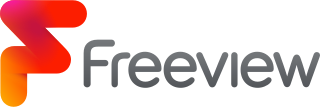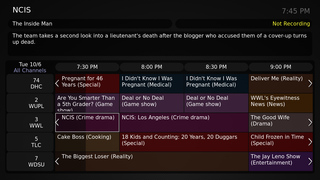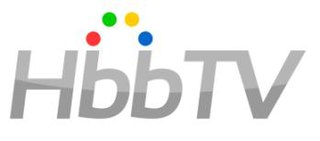Related Research Articles
BBC Red Button is a brand used for digital interactive television services provided by the BBC, and broadcast in the United Kingdom. The services replaced Ceefax, the BBC's analogue teletext service. BBC Red Button's text services were due to close on 30 January 2020, but the switch off was suspended on 29 January 2020 following protests.

A set-top box (STB), also known as a cable box, receiver, or simply box, and historically television decoder or a converter, is an information appliance device that generally contains a TV tuner input and displays output to a television set, turning the source signal into content in a form that can then be displayed on the television screen or other display device. It is designed to be placed alongside or "on top" of a television set.

Freeview is the United Kingdom's sole digital terrestrial television platform. It is operated by Everyone TV and DTV Services Ltd, a joint venture between the BBC, ITV, Channel 4, Channel 5 and Sky. It was launched on 30 October 2002, taking over the licence from ITV Digital which collapsed that year. The service provides consumer access via an aerial to the seven DTT multiplexes covering the United Kingdom. As of July 2020, it has 85 TV channels, 26 digital radio channels, 10 HD channels, six text services, 11 streamed channels, and one interactive channel.

Ceefax was the world's first teletext information service and a forerunner to the current BBC Red Button service. Ceefax was started by the BBC in 1974 and ended, after 38 years of broadcasting, at 23:32:19 BST on 23 October 2012, in line with the digital switchover completion in Northern Ireland.
Television broadcasts in the United Kingdom began in 1932, however, regular broadcasts would only begin four years later. Television began as a public service which was free of advertising, which followed the first demonstration of a transmitted moving image in 1926. Currently, the United Kingdom has a collection of free-to-air, free-to-view and subscription services over a variety of distribution media, through which there are over 480 channels for consumers as well as on-demand content. There are six main channel owners who are responsible for most material viewed.
Teletext Ltd was the provider of teletext and digital interactive services for ITV, Channel 4 and Channel 5 in the United Kingdom.

Top Up TV was a pay TV service in the United Kingdom that was launched in March 2004, operating on the digital terrestrial television platform. The service aimed to "top up" Freeview customers by providing additional content and services through encrypted TV channels unavailable to other viewers.

Electronic programming guides (EPGs) and interactive programming guides (IPGs) are menu-based systems that provide users of television, radio, and other media applications with continuously updated menus that display scheduling information for current and upcoming broadcast programming. Some guides also feature backward scrolling to promote their catch up content. They are commonly known as guides or TV guides.
Digital terrestrial television in the United Kingdom encompasses over 100 television, radio and interactive services broadcast via the United Kingdom's terrestrial television network and receivable with a standard television set. The majority of digital terrestrial television (DTT) services, including the five former analogue channels, are broadcast free-to-air, and a further selection of encrypted pay TV services are also available. Freeview is the only DTT service since Top Up TV closed in 2013.

Sky+ is a discontinued personal video recorder (PVR) and subscription service from the satellite television provider Sky in the UK and Ireland. Launched in September 2001, it allows customers to record, pause and instantly rewind live TV. The system performs these functions using an internal hard drive inside the Sky+ set top box, an upgrade over the standard Digibox.
Freesat is a British free-to-air satellite television service, first formed as a joint venture between the BBC and ITV plc and now owned by Everyone TV. The service was formed as a memorandum in 2007 and has been marketed since 6 May 2008. Freesat offers a satellite alternative to the Freeview service on digital terrestrial television, with a broadly similar selection of channels available without subscription for users purchasing a receiver.
Freesat from Sky (FsfS) was a British satellite television service from Sky UK. It offered over 240 free-to-air (FTA) channels in its EPG. This is a greater number than its competitors, Freesat, which has 200+, and Freeview, which has 70+. It also had up to six HD channels and used to have Sky Active interactive data service. Sky was not actively promoting the service and the service has quietly been discontinued for new customers as of 2021.
Freeview is New Zealand's free-to-air television platform. It is operated by a joint venture between the country's major free-to-air broadcasters – government-owned Television New Zealand and Radio New Zealand, government-subsidised Whakaata Māori, and the American-owned Warner Bros. Discovery.
4TVInteractive was an Electronic Programme Guide (EPG), launched in 2002, for television services in the United Kingdom. The service, which supplied up to 14 days worth of listings data, was available through compatible digital terrestrial television receivers. The service was created by 4TV Limited, before the launch of Freeview's DVB seven-day EPG in 2004, and had been operated by Inview Technology since November 2006.
Digifusion was the brand name of Fusion Digital Technology Limited, a British consumer electronics company that began trading in 2002, producing a range of digital terrestrial televisions and receivers. Fusion was part owned by Beko, the Turkish electronics giant, who were responsible for all product manufacture.
High-definition television in the United Kingdom is available via cable, IPTV, satellite and terrestrial television. The first high-definition broadcasts began in late 2005 and since then the number of channels available to view has grown to a maximum of 87 that can be viewed on pay-TV service, Sky.

Freeview is the brand name of the digital terrestrial television platform in Australia intended to bring all of free-to-air (FTA) broadcasters onto a consistent marketing platform, to compete against subscription television, in particular Foxtel. The strategy coincided with the expansion to 3 digital channels for each FTA network and the phasing out of analogue television in Australia. Important services from Freeview include its free-to-air channels with an enhanced EPG across all channels. Freeview also certifies televisions, set-top boxes and personal video recorders (PVR) which meet its standards.

Hybrid Broadcast Broadband TV (HbbTV) is both an industry standard and promotional initiative for hybrid digital TV to harmonise the broadcast, Internet Protocol Television (IPTV), and broadband delivery of entertainment to the end consumer through connected TVs and set-top boxes. The HbbTV Association, comprising digital broadcasting and Internet industry companies, has established a standard for the delivery of broadcast TV and broadband TV to the home, through a single user interface, creating an open platform as an alternative to proprietary technologies. Products and services using the HbbTV standard can operate over different broadcasting technologies, such as satellite, cable, or terrestrial networks.

Inview Technology is a UK-based digital TV software company. It specialises in advanced EPGs, interactive broadcasts, and IP services for Pay-TV and analogue switch off markets. Their OTT TV platform allows television broadcast and internet content to be simultaneously accessible to the viewer. The company is based in Northwich, Cheshire, UK and is privately owned.
Text to speech in digital television refers to digital television products that use speech synthesis to enable access to blind or partially sighted people. By combining a digital television with a speech synthesis engine, blind and partially sighted people are able to access information that is normally displayed visually in order to operate the menus and electronic program guides of the receiver.
References
- ↑ "Inview Website". Inview Technology Ltd. 7 March 2012.
- ↑ "'Radio Times' Becomes EPG In 3.8 Million Freeview Homes". paidContent:UK. 31 January 2011.
- ↑ "Teletext Extra becomes Radio Times Extra". Digital Spy. 31 January 2011.